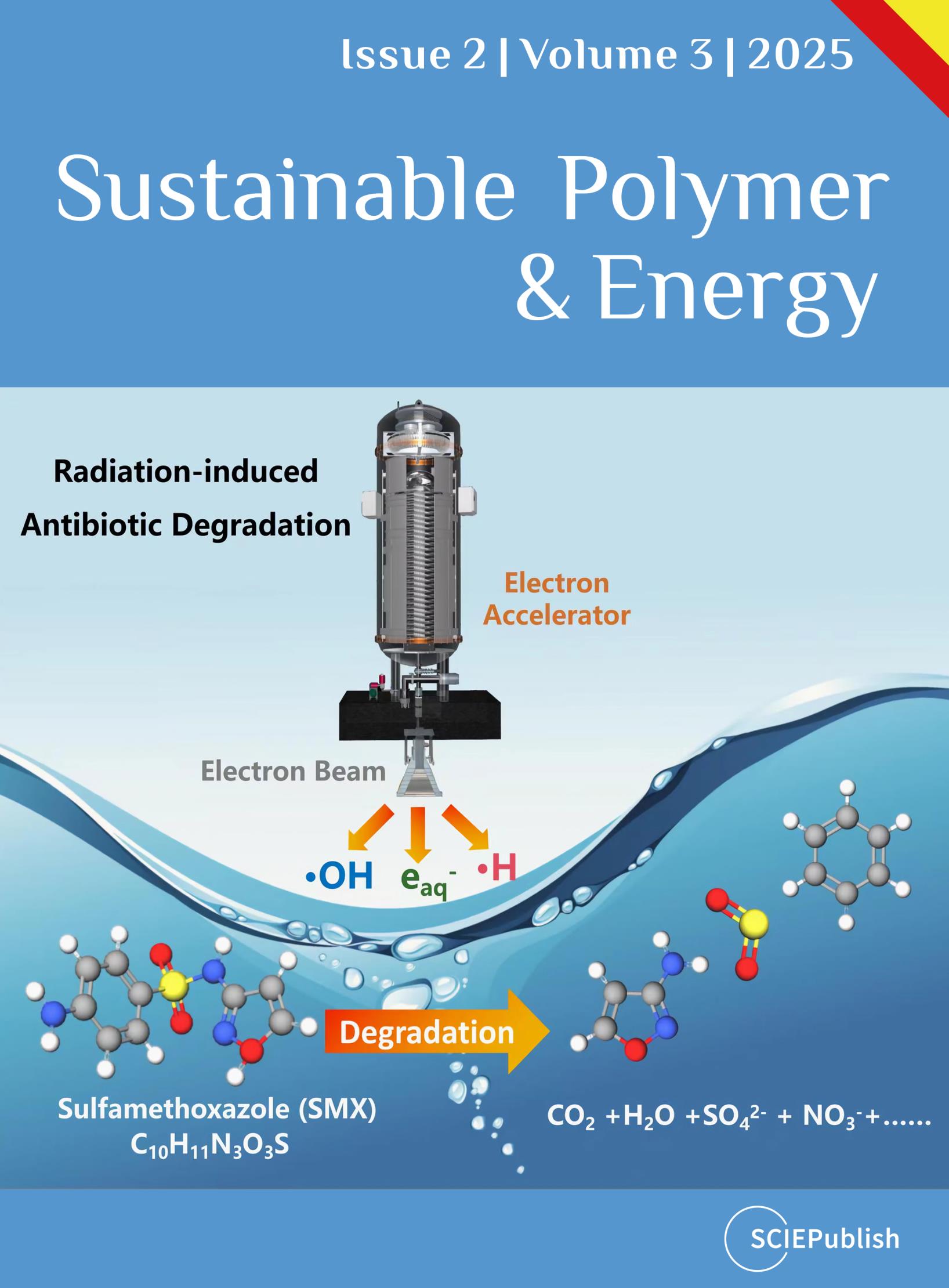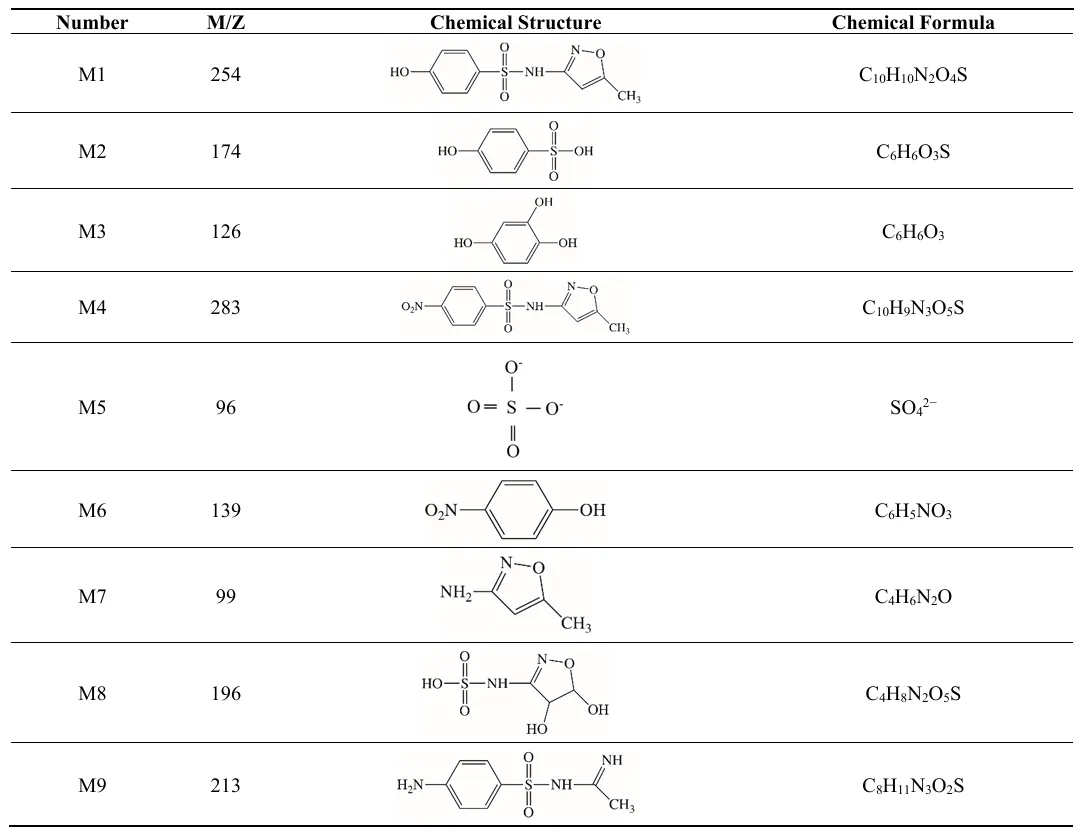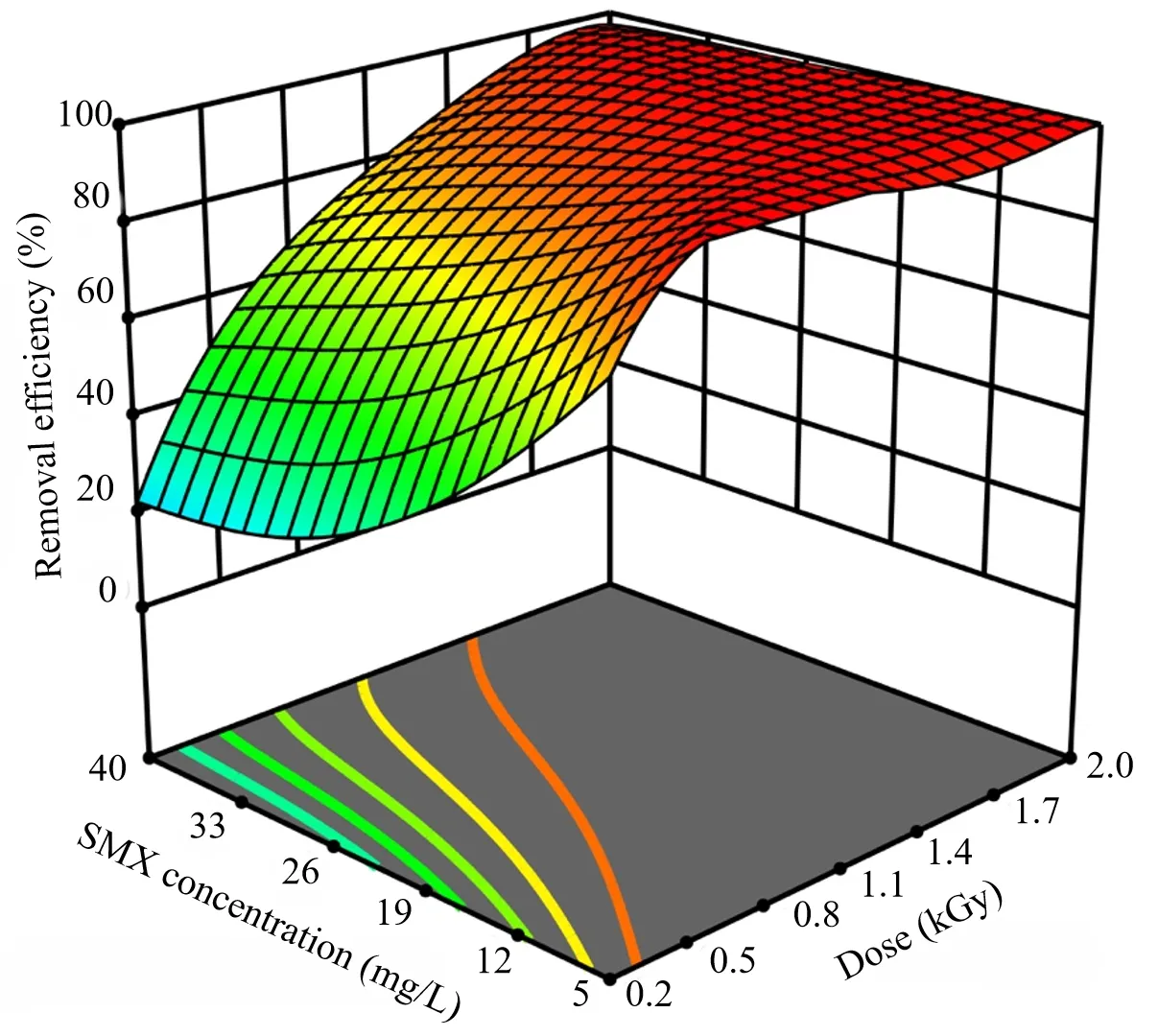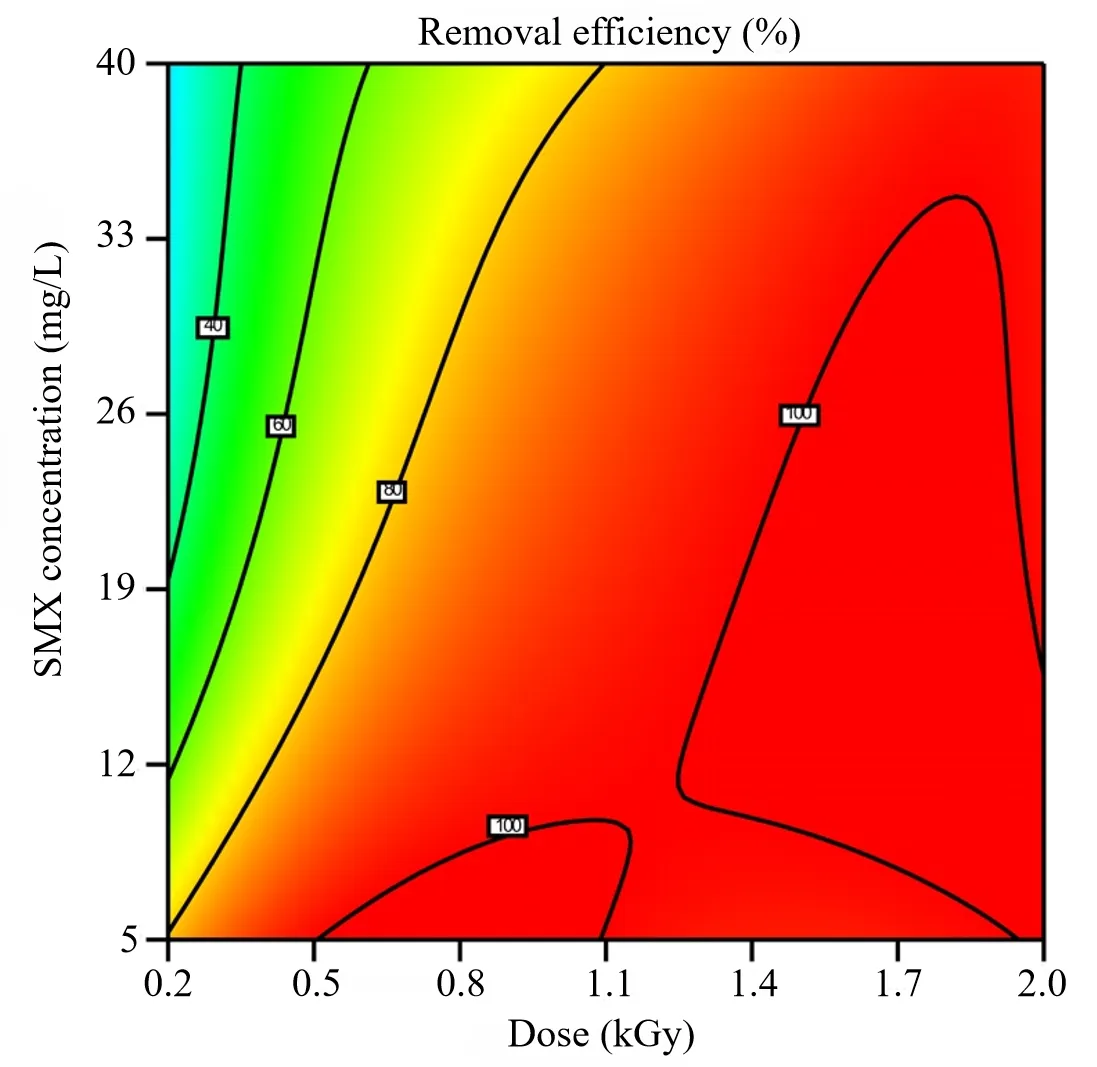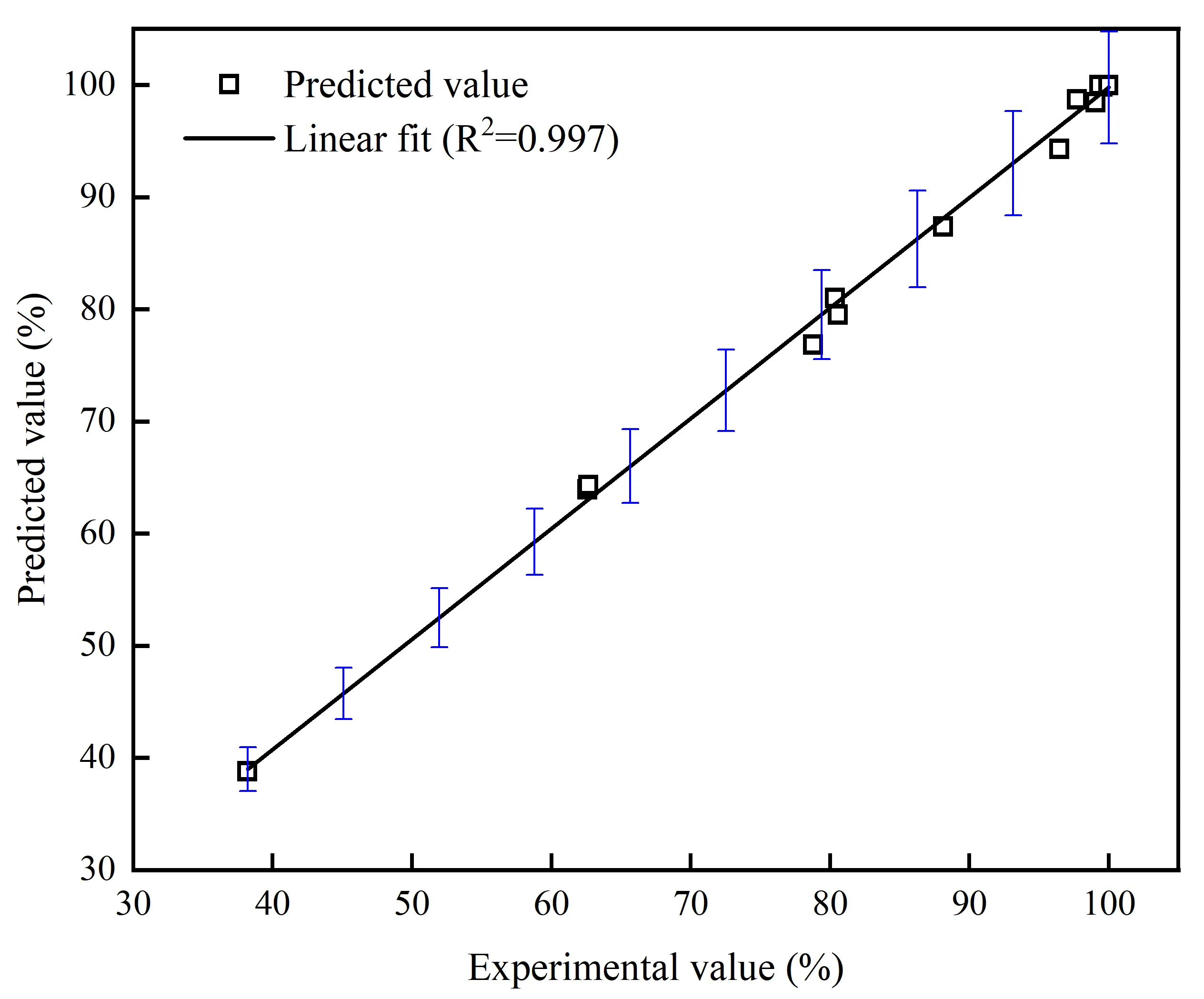1. Introduction
Sulfamethoxazole (SMX), a widely prescribed sulfonamide antibiotic, poses significant environmental risks due to its persistence in aquatic ecosystems and potential to promote antibiotic resistance [
1,
2]. Its high water solubility and environmental persistence (half-life of 10–30 days) lead to its frequent detection in various environmental matrices, including wastewater, surface water, and groundwater [
3,
4]. Studies also have demonstrated that environmental SMX residues pose acute toxicity to aquatic organisms (LC
50 or EC
50 values range from 0.0268 mg/L to >1000 mg/L) [
5] and may facilitate the transmission of resistance genes (ARGs) via horizontal gene transfer [
6,
7], thereby threatening human health and ecological security.
Various technologies have been investigated for the removal of antibiotics from wastewater [
8,
9]. Physical adsorption technology entails the transfer of antibiotics from the aqueous phase to another phase via sequestration and concentration. Yet, it still confronts challenges related to adsorbent regeneration and the risk of secondary pollution. On the other hand, advanced oxidation processes, such as persulfate oxidation and ozonation [
10], face limitations, such as toxic intermediate products and stringent reaction conditions [
11,
12]. For example, conventional Fenton reaction conditions require low pH. Conventional wastewater treatment processes exhibit low SMX removal efficiency (20–58%) [
13,
14] (Adeleye et al., 2022; Wang and Wang, 2018a). Hence, it is crucial to develop novel, high-efficiency technologies for more effective SMX removal from wastewater.
Ionizing irradiation technology has significant potential for environmental protection due to its broad-spectrum degradability and lack of chemical agents [
15,
16,
17,
18,
19]. Recent studies have demonstrated its versatility, including the synthesis of functional hydrogels for selective metal ion adsorption via gamma radiation [
20]. Ionizing radiation technology can directly degrade target pollutants or produce highly oxidizing hydroxyl radicals (•OH) and reductive hydrated electrons (e
aq⁻) through the radiolysis of water molecules, as shown in
Equation (1), which are powerful for the removal of pollutants via oxidation or reduction pathways.
Previous research showed that ionizing irradiation is highly effective in the degradation of drugs and antibiotics in aqueous solution [
21,
22,
23,
24,
25,
26,
27,
28], such as sulfonamides, achieving complete degradation of 20 mg/L SMX at a dose of 1.5 kGy [
29]. Furthermore, compared with UV/persulfate systems, radiation technology has shown greater adaptability to complex water matrices (e.g., containing humic acid or inorganic anions) [
14]. The combination of ionizing radiation and ozone pretreatment markedly enhances the mineralization rate of SMX [
30].
Response Surface Methodology (RSM) has gained traction in environmental engineering for its ability to model complex interactions between variables while minimizing experimental runs, emerging as a statistically robust framework for optimizing advanced oxidation processes (AOPs) [
31,
32]. By integrating mathematical modeling with experimental design, RSM systematically explores parameter interactions and identifies optimal conditions while minimizing experimental trials—a critical advantage for scaling water treatment technologies [
33,
34]. Recent advancements highlight its efficacy in antibiotic removal, particularly for recalcitrant pharmaceuticals like sulfamethoxazole (SMX), where nonlinear relationships between process variables govern degradation efficiency [
35,
36].
Since in ionizing irradiation technology, reactive species generation (e.g., •OH, e
aq⁻) is inherently governed by nonlinear relationships between absorbed dose, pollutant concentration, and competing water constituents. Traditional single-factor approaches often fail to capture these interdependencies, necessitating multivariate optimization frameworks. Traditional single-factor approaches often fail to capture these dynamics, necessitating multivariate frameworks like RSM to unravel synergistic or antagonistic effects [
37].
This study integrated response surface methodology (RSM) with gamma radiation to optimize SMX degradation. Building on previous kinetics data [
29], we developed a predictive model to elucidate the interplay between absorbed dose (0.2–2.0 kGy) and initial SMX concentration (5–40 mg/L). The model not only identifies optimal conditions for near-complete degradation but also provides a framework for scaling up irradiation-based treatments, advancing the implementation of radiation technology for antibiotic-laden wastewater remediation incomplete matrices.
2. Materials and Methods
2.1. Chemicals
SMX (SMX, C
10H
11N
3O
3S, purity >98%) is supplied by Aladdin Industries (Shanghai, China). A 200 mg/L SMX stock solution was prepared with deionized water prior to use. Raw materials, including NaNO
3, Na
2CO
3, NaHCO
3, Na
2SO
4, NaCl, Na
2HPO
4, peptone, and glucose, were purchased from Xilong Chemical Co., Ltd. H
2SO
4, NaOH, and humic acid were obtained from Beijing Chemical Reagent (Beijing, China).
2.2. Irradiation Experiment
The irradiation experiment was performed using
60Co-γ irradiation source from the Institute of Nuclear and New Energy Technology of Tsinghua University, with a dose rate of 339 Gy/min. The irradiation time is determined by the absorbed dose rate at this point and the required absorbed dose (0.2–2.0 kGy). The SMX solution sample was kept in a plastic centrifuge tube and irradiated near the irradiator at ambient temperature.
2.3. Analytical Methods
Aqueous SMX solution samples at different initial concentrations were prepared by diluting the 200 mg/L SMX stock solution with deionized water. SMX concentrations were measured by high-performance liquid chromatography (HPLC, 1200 Series, Agilent, Santa Clara, CA, USA) [
14]. The column was a C18 reversed-phase column (5 mm, 4.6 × 150 mm) with a column temperature set at 30 °C, a mixed solution of 55% acetonitrile and 45% formic acid (0.1%) with a flow rate of 1 mL/min, a diode array detector (DAD) detector at 275 ± 10 nm, a 6-min run time, a retention time of approximately 2.0 min for SMX, and a 20 μL injection volume [
29].
2.4. RSM Modeling
The Box-Behnken design was employed to construct the response surface model. According to the previous research on the degradation of SMX aqueous solution by low-energy X-ray irradiation, the absorbed dose directly impacts the number of active particles generated by gamma radiation and significantly influences the SMX degradation rate [
28]. Moreover, generally, SMX degradation efficiency slightly decreases as its initial concentration increases [
36,
37,
38]. Hence, in this study, absorbed dose (A, kGy) and initial SMX concentration (B, mg/L) were chosen as independent variables. The absorbed dose ranged from 0.2 to 2.0 kGy, and the concentration of SMX ranged from 5 to 40 mg/L. These ranges were determined based on previous experimental results [
39] and actual sewage treatment requirements. The experimental data were input into the Design Expert software, and a quadratic response regression model was formulated in the following form
Equation (2):
where Y represents the SMX removal rate (%), A denotes the absorbed dose (kGy), and B represents the SMX concentration (mg/L).
β0 is a constant,
β1 and
β2 are linear coefficients,
β12 is the interaction coefficient, and
β11 and
β22 are quadratic coefficients. The significance and goodness of fit of the model were assessed via analysis of variance (ANOVA), and the residual analysis was performed to confirm the alignment between the model’s predicted values and the experimental data.
3. Results and Discussion
3.1. SMX Degradation
The gamma radiation-induced degradation of sulfamethoxazole (SMX) has been studied by our group under varying absorbed doses (0.2–2.0 kGy) and initial concentrations (5–40 mg/L) [
40], with degradation efficiencies exceeding 99% at optimal conditions (≥1.2 kGy for 5–10 mg/L SMX). This investigation also built upon foundational kinetics data from Zhuan & Wang (2019) [
29]. Liquid chromatography-mass spectrometry (LC-MS) analysis of irradiated samples (10 mg/L SMX, 0.8 kGy dose) identified nine intermediate degradation products (M1–M9;
), elucidating a multi-pathway degradation mechanism dominated by hydroxyl radical (⋅OH) and hydrated electron (e
aq⁻) reactions (
).
. Intermediates of Sulfamethoxazole Degradation by Ionizing Irradiation.
The first step is initial •OH attack occurs at the electron-rich aniline group of SMX, forming hydroxylated derivatives (M1), demonstrating that oxidative substitutions at aromatic amines are primary pathways in advanced oxidation processes (AOPs) for sulfonamides. Then, the S–N bond in SMX undergoes hydrolysis or radical-mediated scission, yielding M2 and subsequent desulfonation to M3 (M/Z 126), sulfonamide bond (SN) breaking has been reported in other degradation processes of sulfamethoxazole [
41]. This pathway was also corroborated [
42], who demonstrated that reductive species preferentially destabilize sulfonamide bonds in SMX derivatives M4 arising from nitro-group addition to the hydroxylated aromatic ring, a pathway enhanced at higher irradiation doses. This mirrors observations in chlorination systems, where halogenated byproducts form via similar electrophilic substitution [
43]. Subsequent breakage of the arylsulfone (CS) and sulfonamide (SN) bonds under hydroxyl radical oxidation yielded the products M5 (M/Z 96), M6 (M/Z 139), and M7 (M/Z 99). Fragmentation of the benzene ring via •OH attack produces M6, consistent with aromatic ring-opening mechanisms reported in irradiated phenolic compounds [
44]. These intermediates are also aligned with chlorination byproducts identified [
44], though irradiation avoids toxic chlorinated analogues. Further •OH attack on the heterocyclic ring leads to ring-opening products. M8 and M9 are characterized by fragmented isoxazole moieties, consistent with pathways reported in electron beam irradiation (EBI) studies [
45].
. Possible pathways for degradation of sulfamethoxazole by ionizing irradiation.
The Box-Behnken design was employed to construct a quadratic regression model (
Equation (2)) based on experimental data from Zhuan (2020) [
40] with Design Expert. The model links the irradiation dose (A) and SMX concentration (B) to the removal efficiency (Y). Analysis of variance (ANOVA) was conducted to evaluate the significance of the model terms (
). The regression equation derived from the experimental data is expressed as
Equation (3):
Among them, A represents the absorbed dose (kGy), B represents the SMX concentration (mg/L), and Y represents SMX removal efficiency (%).
The model exhibited high predictive accuracy (
R2 = 0.9931,
Radj2 = 0.9883) and statistical significance (
F-value = 206.32,
p < 0.0001). The ANOVA results (
) indicated that absorbed dose (A), SMX concentration (B), and their interactions (AB, A
2B, AB
2) were the dominant factors influencing SMX degradation.
.
ANOVA results for the regression model for SMX degradation.
| Source of Variance |
Sum of Squares |
Degree of Freedom |
Mean Square |
F-Value |
p-Value |
| Model |
17,507.68 |
14 |
1250.55 |
206.32 |
<0.0001 |
| A-Absorbed dose |
454.09 |
1 |
454.09 |
74.92 |
<0.0001 |
| B-SMX concentration |
118.11 |
1 |
118.11 |
19.49 |
0.0003 |
| AB |
149.41 |
1 |
149.41 |
24.65 |
<0.0001 |
| A2 |
44.50 |
1 |
44.50 |
7.34 |
0.0135 |
| B2 |
1.01 |
1 |
1.01 |
0.1673 |
0.6869 |
| A2B |
79.57 |
1 |
79.57 |
13.13 |
0.0017 |
| AB2 |
184.55 |
1 |
184.55 |
30.45 |
<0.0001 |
| A3 |
260.65 |
1 |
260.65 |
43.00 |
<0.0001 |
| B3 |
0.2303 |
1 |
0.2303 |
0.0380 |
0.8474 |
| A2B2 |
153.55 |
1 |
153.55 |
25.33 |
<0.0001 |
| A3B |
21.72 |
1 |
21.72 |
3.58 |
0.0729 |
| AB3 |
0.6124 |
1 |
0.6124 |
0.1010 |
0.7539 |
| A4 |
41.91 |
1 |
41.91 |
6.92 |
0.0161 |
| B4 |
1.99 |
1 |
1.99 |
0.3291 |
0.5726 |
| Residual |
121.22 |
20 |
6.06 |
|
|
| Sum |
17,628.90 |
34 |
|
|
|
| R2 = 0.9931, R2adj = 0.9883 |
As shown in the table above, the model has an
F-value of 206.32 and a
p-value less than 0.0001, with a correlation coefficient (
R2) of 0.9931 and an adjusted
R2adj of 0.9883, indicating a high degree of fit and providing a good prediction of the actual treatment outcomes.
3.3. Interaction Effects and Parameter Optimization
To elucidate the interaction between absorbed dose (A) and SMX concentration (B),
Equation (4) and
Equation (5) were derived by solving the 100% removal rate thresholds:
When the absorbed dose is between 0.5 and 1.1 kGy, and the SMX concentration is between 5 and 10 mg/L, the equation f(x,y) is satisfied in
Equation (4):
When the absorbed dose is between 1.2 and 2 kGy and the SMX concentration is between 5 and 35 mg/L, the equation g(x,y) is satisfied in
Equation (5):
Here, x represents the irradiation dose (kGy), and y represents the SMX concentration (mg/L). When the absorbed dose and the SMX concentration are substituted into the above two equations and calculated to be greater than or equal to zero, the removal rate is close to 100%.
As shown in
(3D surface plot) and
(contour plot), SMX removal efficiency increased monotonically with the absorbed dose but decreased at higher SMX concentrations. This trend is attributed to the enhanced generation of reactive species (e.g., •OH and e
aq−) at higher doses, while elevated SMX concentrations intensified competition for these species, reducing degradation efficiency [
3,
12].
. 3D surface plot of SMX removal efficiency under varying irradiation doses and SMX concentrations.
. Contour plot of irradiation dose <i>vs.</i> SMX concentration on removal efficiency.
Optimal conditions (≥1.2 kGy) achieved near-complete removal (100%) for low SMX concentration (5−10 mg/L), validating the model’s utility in parameter optimization.
3.4. Model Validation
To validate the model’s predictive capability, experimental data from Zhuan (2020) [
37] were compared with predicted values in
. A strong linear correlation (
R2 = 0.997) was observed, with errors confined to ±2%.
. Correlation between experimental and predicted SMX removal efficiency.
This alignment confirms the model’s reliability for optimizing irradiation parameters in complex water matrices. Hence, the comparison of experimental data and model predictions confirms that the established response surface model effectively predicts the degradation efficiency of SMX under varying irradiation doses and SMX concentrations.
4. Conclusions
This study indicated the degradation pathways of SMX using gamma radiation and developed a prediction model for optimizing the degradation efficiency using response surface methodology (RSM). The accuracy and reliability of the model were validated by comparing it with experimental data. The main conclusions are as follows: (1) The RSM model demonstrated fine predictive accuracy (R2 = 0.9931) and a high degree of fitness, validating its utility in resolving the nonlinear interplay between absorbed dose and SMX concentration. (2) Degradation pathways, inferred from nine identified intermediates, highlighted the dominance of •OH-mediated hydroxylation and eaq–-driven sulfonamide bond cleavage. (3) Optimal conditions (≥1.2 kGy, 5–10 mg/L SMX) achieved near-complete degradation, with intermediate toxicity analyses suggesting minimal ecological risks. These insights not only validate the principles of radiation-driven degradation but also bridge the gap between empirical optimization and mechanistic validation, a perspective underexplored in prior studies. Future research could focus on factors such as water quality and radiation types to optimize and expand the application scope of ionizing irradiation technology, thereby meeting the increasing requirements for the safe and efficient treatment of antibiotic wastewater.
Author Contributions
Y.S.: Data curation, Formal analysis, Investigation, Writing—original draft; Y.W.: Data curation, Investigation; J.W.: Funding acquisition, Supervision, Writing—review & editing.
Ethics Statement
Not applicable.
Informed Consent Statement
Not applicable.
Data Availability Statement
Data will be available upon request.
Funding
The research was funded by the Key Program for Intergovernmental S&T Innovative Cooperation Project of China (2024YFE0101700).
Declaration of Competing Interest
No potential conflict of interest was reported by the authors.
References
1.
Omotola EO, Oluwole AO, Oladoye PO, Olatunji OS. Occurrence, Detection and Ecotoxicity Studies of Selected Pharmaceuticals in Aqueous Ecosystems- a Systematic Appraisal.
Environ. Toxicol. Pharmacol. 2022,
91, 103831.
[Google Scholar]
2.
Rana S, Kumar A, Dhiman P, Mola GT, Sharma G, Lai CW. Recent Advances in Photocatalytic Removal of Sulfonamide Pollutants from Waste Water by Semiconductor Heterojunctions: A Review.
Mater. Today Chem. 2023,
30, 101603.
[Google Scholar]
3.
Wang J, Zhuan R, Chu L. The Occurrence, Distribution and Degradation of Antibiotics by Ionizing Radiation: An Overview.
Sci. Total Environ. 2019,
646, 1385–1397.
[Google Scholar]
4.
Moghadam AA, Shuai W, Hartmann EM. Anthropogenic Antimicrobial Micropollutants and Their Implications for Agriculture.
Curr. Opin. Biotechnol. 2023,
80, 102902.
[Google Scholar]
5.
Feng P, Wu J, Cui H, Huang X, Wang C, Wang C, et al. Effects of Environmental Concentrations of Sulfamethoxazole on Skeletonema Costatum and Phaeodactylum Tricornutum: Insights into Growth, Oxidative Stress, Biochemical Components, Ultrastructure, and Transcriptome.
Ecotoxicol. Environ. Saf. 2024,
283, 116851.
[Google Scholar]
6.
Tao Y, Zhou C, Xie Y, Chen A, Liu K, Wu X, et al. Effects of Long-Term Exposure to Sulfamethoxazole on the Sediments in Sewage Pipe: Extracellular Polymeric Substance, Microbial Communities, and Antibiotic Resistance Genes.
J. Environ. Chem. Eng. 2024,
13, 115116.
[Google Scholar]
7.
Wang J, Chen X. Removal of Antibiotic Resistance Genes (ARGs) in Various Wastewater Treatment Processes: An Overview.
Crit. Rev. Environ. Sci. Technol. 2020,
52, 571–630.
[Google Scholar]
8.
Wang J, Zhuan R. Degradation of Antibiotics by Advanced Oxidation Processes: An Overview.
Sci. Total Environ. 2020,
701, 135023.
[Google Scholar]
9.
Kovács K, Székely D, Tegze A, Homlok R, Bezsenyi A, Wojnárovits L. Gamma and Pulse Radiolysis of Trimethoprim in Aqueous Solutions: Intermediate Radicals, Rate of Oxidation, Toxicity.
J. Water Process Eng. 2024,
69, 106743–106743.
[Google Scholar]
10.
del Mar Gómez-Ramos M, Mezcua M, Agüera A, Fernández-Alba AR, Gonzalo S, Rodríguez A, et al. Chemical and Toxicological Evolution of the Antibiotic Sulfamethoxazole under Ozone Treatment in Water Solution.
J. Hazard. Mater. 2011,
192, 18–25.
[Google Scholar]
11.
Liu X, Wang J. Decolorization and Degradation of Various Dyes and Dye-Containing Wastewater Treatment by Electron Beam Radiation Technology: An Overview.
Chemosphere 2024,
351, 141255.
[Google Scholar]
12.
Wang N, Zheng T, Zhang G, Wang P. A Review on Fenton-like Processes for Organic Wastewater Treatment.
J. Environ. Chem. Eng. 2016,
4, 762–787.
[Google Scholar]
13.
Adeleye AS, Xue J, Zhao Y, Taylor AA, Zenobio JE, Sun Y, et al. Abundance, Fate, and Effects of Pharmaceuticals and Personal Care Products in Aquatic Environments.
J. Hazard. Mater. 2022,
424, 127284.
[Google Scholar]
14.
Wang S, Wang J. Radiation-Induced Degradation of Sulfamethoxazole in the Presence of Various Inorganic Anions.
Chem. Eng. J. 2018,
351, 688–696.
[Google Scholar]
15.
Huang X, Wen D, Wang J. Radiation-Induced Degradation of Sulfonamide and Quinolone Antibiotics: A Brief Review.
Radiat. Phys. Chem. 2024,
215, 111373.
[Google Scholar]
16.
Yao B, Zhou Y. Enhanced Degradation of Sulfathiazole by Ionizing Radiation Activated Persulfate and Periodate: Performances and Mechanisms.
Chem. Eng. J. 2024,
496, 154284.
[Google Scholar]
17.
Chen L, Shao H, Mao C, Ren Y, Zhao T, Tu M, et al. Degradation of Hexavalent Chromium and Naphthalene by Electron Beam Irradiation: Degradation Efficiency, Mechanisms, and Degradation Pathway.
Chemosphere 2023,
336, 138992.
[Google Scholar]
18.
Takács E, Wang J, Chu L, Tóth T, Kovács K, Bezsenyi A, et al. Elimination of Oxacillin, Its Toxicity and Antibacterial Activity by Using Ionizing Radiation.
Chemosphere 2022,
286, 131467.
[Google Scholar]
19.
Xu G, Yao J, Tang L, Yang X, Zheng M, Wang H, et al. Electron Beam Induced Degradation of Atrazine in Aqueous Solution.
Chem. Eng. J. 2015,
275, 374–380.
[Google Scholar]
20.
Bhuyan MM, Jophous M, Jeong J-H. Synthesis and Characterization of Gamma Radiation-Induced (3-Acrylamidopropyl) Trimethylammonium Chloride-Acrylic Acid Functional Superabsorbent Hydrogel.
Polym. Bull. 2022,
80, 8651–8664.
[Google Scholar]
21.
Huo Z, Wang S, Shao H, Wang H, Xu G. Radiolytic Degradation of Anticancer Drug Capecitabine in Aqueous Solution: Kinetics, Reaction Mechanism, and Toxicity Evaluation.
Environ. Sci. Pollut. Res. 2020,
27, 20807–20816.
[Google Scholar]
22.
Alsager OA, Alnajrani MN, Alhazzaa O. Decomposition of Antibiotics by Gamma Irradiation: Kinetics, Antimicrobial Activity, and Real Application in Food Matrices.
Chem. Eng. J. 2018,
338, 548–556.
[Google Scholar]
23.
Sági G, Bezsenyi A, Kovács K, Klátyik S, Darvas B, Székács A, et al. Radiolysis of Sulfonamide Antibiotics in Aqueous Solution: Degradation Efficiency and Assessment of Antibacterial Activity, Toxicity and Biodegradability of Products.
Sci. Total Environ. 2018, 622–623, 1009–1015.
[Google Scholar]
24.
Shao H, Wu M, Deng F, Xu G, Liu N, Li X, et al. Electron Beam Irradiation Induced Degradation of Antidepressant Drug Fluoxetine in Water Matrices.
Chemosphere 2018,
190, 184–190.
[Google Scholar]
25.
Tegze A, Sági G, Kovács K, Homlok R, Tóth T, Mohácsi-Farkas C, et al. Degradation of Fluoroquinolone Antibiotics during Ionizing Radiation Treatment and Assessment of Antibacterial Activity, Toxicity and Biodegradability of the Products.
Radiat. Phys. Chem. 2018,
147, 101–105.
[Google Scholar]
26.
Szabó L, Szabó J, Illés E, Kovács A, Belák Á, Mohácsi-Farkas C, et al. Electron Beam Treatment for Tackling the Escalating Problems of Antibiotic Resistance: Eliminating the Antimicrobial Activity of Wastewater Matrices Originating from Erythromycin.
Chem. Eng. J. 2017,
321, 314–324.
[Google Scholar]
27.
Wojnárovits L, Takács E. Wastewater Treatment with Ionizing Radiation.
J. Radioanal. Nucl. Chem. 2016,
311, 973–981.
[Google Scholar]
28.
Liu N, Wang T, Zheng M, Lei J, Tang L, Hu G, et al. Radiation Induced Degradation of Antiepileptic Drug Primidone in Aqueous Solution.
Chem. Eng. J. 2015,
270, 66–72.
[Google Scholar]
29.
Zhuan R, Wang J. Degradation of Sulfamethoxazole by Ionizing Radiation: Kinetics and Implications of Additives.
Sci. Total Environ. 2019,
668, 67–73.
[Google Scholar]
30.
Chu L, Wang J. Degradation of Antibiotics in Activated Sludge by Ionizing Radiation: Effect of Adsorption Affinity of Antibiotics.
Chem. Eng. J. 2023,
468, 143821.
[Google Scholar]
31.
Khammar S, Bahramifar N, Younesi H. Preparation and Surface Engineering of CM-β-CD Functionalized Fe3O4@TiO2 Nanoparticles for Photocatalytic Degradation of Polychlorinated Biphenyls (PCBs) from Transformer Oil.
J. Hazard. Mater. 2020,
394, 122422.
[Google Scholar]
32.
Asgari G, Shabanloo A, Salari M, Eslami F. Sonophotocatalytic Treatment of AB113 Dye and Real Textile Wastewater Using ZnO/Persulfate: Modeling by Response Surface Methodology and Artificial Neural Network.
Environ. Res. 2020,
184, 109367.
[Google Scholar]
33.
Ciğeroğlu Z, Şahin S, Kazan ES. One-Pot Green Preparation of Deep Eutectic Solvent-Assisted ZnO/GO Nanocomposite for Cefixime Trihydrate Photocatalytic Degradation under UV-A Irradiation.
Biomass Convers. Biorefinery 2021,
12 (S1), 73–86.
[Google Scholar]
34.
Naimi-joubani M, Ayagh K, Tahergorabi M, Shirzad-Siboni M, Yang JK. Design and Modeling of Diazinon Degradation in Hydrous Matrix by Ni-Doped ZnO Nanorods under Ultrasonic Irradiation: Process Optimization Using RSM (CCD), Kinetic Study, Reaction Pathway, Mineralization, and Toxicity Assessment.
Environ. Sci. Pollut. Res. 2022,
30, 3527–3548.
[Google Scholar]
35.
Zhang T, Hu C, Li Q, Chen C, Hu J, Xiao X, et al. Hydrogen Peroxide Activated by Biochar-Supported Sulfidated Nano Zerovalent Iron for Removal of Sulfamethazine: Response Surface Method Approach.
Int. J. Environ. Res. Public Health 2022,
19, 9923–9923.
[Google Scholar]
36.
Liu G, Zhang X, Liu H, He Z, Show PL, Vasseghian Y, et al. Biochar/Layered Double Hydroxides Composites as Catalysts for Treatment of Organic Wastewater by Advanced Oxidation Processes: A Review.
Environ. Res. 2023,
234, 116534.
[Google Scholar]
37.
Mitsika EE, Christophoridis C, Kouinoglou N, Lazaridis N, Zacharis CK, Fytianos K. Optimized Photo-Fenton Degradation of Psychoactive Pharmaceuticals Alprazolam and Diazepam Using a Chemometric Approach—Structure and Toxicity of Transformation Products.
J. Hazard. Mater. 2021,
403, 123819.
[Google Scholar]
38.
Chen H, Wan J, Yan Z, Ma Y, Wang Y, Xie Y, et al. Construction of Ultra-High Defective Iron-Based Metal Organic Frameworks with Small Molecule Acid Regulator for Enhanced Degradation of Sulfamethoxazole.
J. Clean. Prod. 2022,
348, 131367.
[Google Scholar]
39.
Abbas Y, Ali S, Ali S, Azeem W, Zuhra Z, Wang H, et al. Cyclotriphosphazene (P3N3) Derived FeOx@SPNO-C Core–Shell Nanospheres as Peroxymonosulfate Activator for Degradation via Non-Radical Pathway.
Appl. Surf. Sci. 2023,
645, 158836.
[Google Scholar]
40.
Zhuan R. Research on Degradation and Mineralization of Antibiotics by Ionizing Radiation. Master Degree Thesis, Tsinghua University, Beijing, China, 2020.
41.
Kim HY, Kim T-H, Cha SM, Yu S. Degradation of Sulfamethoxazole by Ionizing Radiation: Identification and Characterization of Radiolytic Products.
Chem. Eng. J. 2017,
313, 556–566.
[Google Scholar]
42.
Hu L, Flanders PM, Miller PL, Strathmann TJ. Oxidation of Sulfamethoxazole and Related Antimicrobial Agents by TiO
2 Photocatalysis.
Water Res. 2007,
41, 2612–2626.
[Google Scholar]
43.
Wang X, Li J, Zhang C, Xue M, Xie H. Degradation Products and Transformation Pathways of Sulfamethoxazole Chlorination Disinfection By-Products in Constructed Wetlands.
Environ. Res. 2024,
249, 118343.
[Google Scholar]
44.
Alkhuraiji TS, Boukari SOB, Alfadhl FS. Gamma Irradiation-Induced Complete Degradation and Mineralization of Phenol in Aqueous Solution: Effects of Reagent.
J. Hazard. Mater. 2017,
328, 29–36.
[Google Scholar]
45.
Kengne BT, Sun Y, Wang S, Wang J, Bulka S, Pyszynska M, et al. Kinetic Analysis and Transformation Pathways of Sulfamethoxazole Degradation in Water and Wastewater under Electron Beam Irradiation.
Water 2025,
17, 1596–1596.
[Google Scholar]
